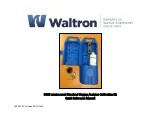
12
ADHESIVE MOUNTING BUSHINGS
An adhesive mounting bushing may be
bonded to an object so that the
accelerometer may be screwed into the
bushing rather than into the object being
measured. This is appropriate for those
applications where it is not practical to
drill into an object for stud mounting. It is
also appropriate for applications where it
is anticipated that the accelerometer will
need to be removed periodically.
The bushings may be welded or
adhesively bonded in place. Care
should be taken when bonding the
bushings to make certain no adhesive is
allowed to seep into the bushing's
mounting hole.
This can be avoided by threading the accelerometer or a dummy bolt
i
nto the
bushing before bonding It to the surface. Additional care should be taken to
prevent uncured adhesive from being drawn up through the hole when the
accelerometer or bolt is removed.
MAGNETIC MOUNTING
Magnets are not generally recommended for measurements above 5KHz. They
are quite adequate for lower frequency measurements and can be helpful when
a single accelerometer is used to measure a great number of points. The
obvious requirement is that the measurement point must be ferro-magnetic so
that the magnet can stick to
it.
A flat magnet with smooth machined surfaces and perpendicular mounting hole
is recommended. This allows the magnet to bond efficiently to the mounting
surface providing good dynamic transmissibility. For those points where the
magnet does not seat well, it may be necessary to bond a sizeable ferro-
magnetic bushing. Note that most adhesive mounting bushings are made of
Series 300 stainless steel which will not rust and is not ferro·magnetic.
As with other mounting techniques, a thin film of grease can be used to enhance
the dynamic transmissibility when using a magnet.
Using horse-shoe (or U-shaped) magnets on curved surfaces, although
popular, should be restricted to measurements below 1 KHz. See figure 7-3 for
an example of magnetic mounting.
Figure 7-2. Adhesive
Mounting Bushing












































